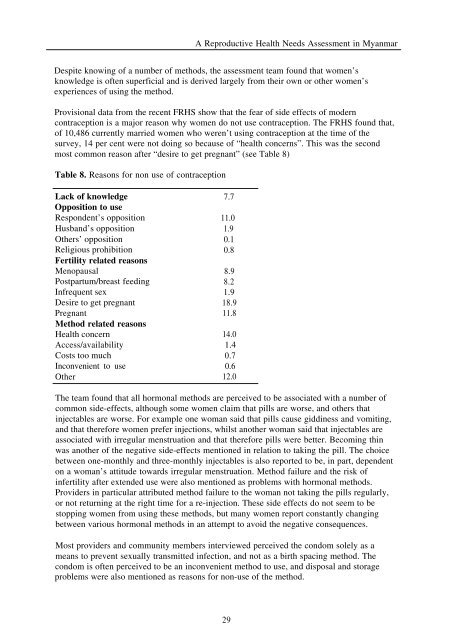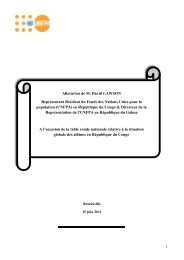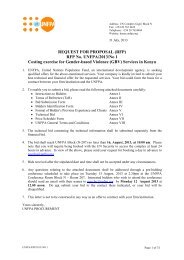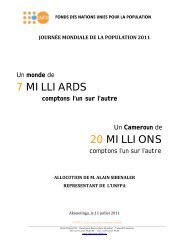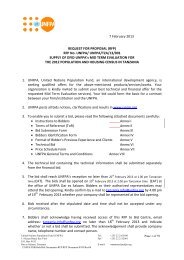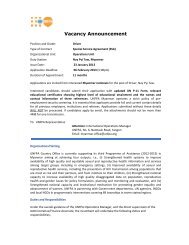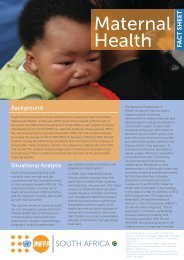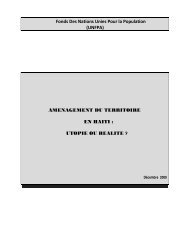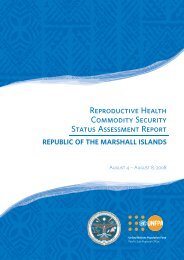A reproductive health needs assessment in Myanmar
A reproductive health needs assessment in Myanmar
A reproductive health needs assessment in Myanmar
Create successful ePaper yourself
Turn your PDF publications into a flip-book with our unique Google optimized e-Paper software.
A Reproductive Health Needs Assessment <strong>in</strong> <strong>Myanmar</strong><br />
Despite know<strong>in</strong>g of a number of methods, the <strong>assessment</strong> team found that women’s<br />
knowledge is often superficial and is derived largely from their own or other women’s<br />
experiences of us<strong>in</strong>g the method.<br />
Provisional data from the recent FRHS show that the fear of side effects of modern<br />
contraception is a major reason why women do not use contraception. The FRHS found that,<br />
of 10,486 currently married women who weren’t us<strong>in</strong>g contraception at the time of the<br />
survey, 14 per cent were not do<strong>in</strong>g so because of “<strong>health</strong> concerns”. This was the second<br />
most common reason after “desire to get pregnant” (see Table 8)<br />
Table 8. Reasons for non use of contraception<br />
Lack of knowledge<br />
Opposition to use<br />
Respondent’s opposition<br />
Husband’s opposition<br />
Others’ opposition<br />
Religious prohibition<br />
Fertility related reasons<br />
Menopausal<br />
Postpartum/breast feed<strong>in</strong>g<br />
Infrequent sex<br />
Desire to get pregnant<br />
Pregnant<br />
Method related reasons<br />
Health concern<br />
Access/availability<br />
Costs too much<br />
Inconvenient to use<br />
Other<br />
7.7<br />
11.0<br />
1.9<br />
0.1<br />
0.8<br />
8.9<br />
8.2<br />
1.9<br />
18.9<br />
11.8<br />
14.0<br />
1.4<br />
0.7<br />
0.6<br />
12.0<br />
The team found that all hormonal methods are perceived to be associated with a number of<br />
common side-effects, although some women claim that pills are worse, and others that<br />
<strong>in</strong>jectables are worse. For example one woman said that pills cause gidd<strong>in</strong>ess and vomit<strong>in</strong>g,<br />
and that therefore women prefer <strong>in</strong>jections, whilst another woman said that <strong>in</strong>jectables are<br />
associated with irregular menstruation and that therefore pills were better. Becom<strong>in</strong>g th<strong>in</strong><br />
was another of the negative side-effects mentioned <strong>in</strong> relation to tak<strong>in</strong>g the pill. The choice<br />
between one-monthly and three-monthly <strong>in</strong>jectables is also reported to be, <strong>in</strong> part, dependent<br />
on a woman’s attitude towards irregular menstruation. Method failure and the risk of<br />
<strong>in</strong>fertility after extended use were also mentioned as problems with hormonal methods.<br />
Providers <strong>in</strong> particular attributed method failure to the woman not tak<strong>in</strong>g the pills regularly,<br />
or not return<strong>in</strong>g at the right time for a re-<strong>in</strong>jection. These side effects do not seem to be<br />
stopp<strong>in</strong>g women from us<strong>in</strong>g these methods, but many women report constantly chang<strong>in</strong>g<br />
between various hormonal methods <strong>in</strong> an attempt to avoid the negative consequences.<br />
Most providers and community members <strong>in</strong>terviewed perceived the condom solely as a<br />
means to prevent sexually transmitted <strong>in</strong>fection, and not as a birth spac<strong>in</strong>g method. The<br />
condom is often perceived to be an <strong>in</strong>convenient method to use, and disposal and storage<br />
problems were also mentioned as reasons for non-use of the method.<br />
29


